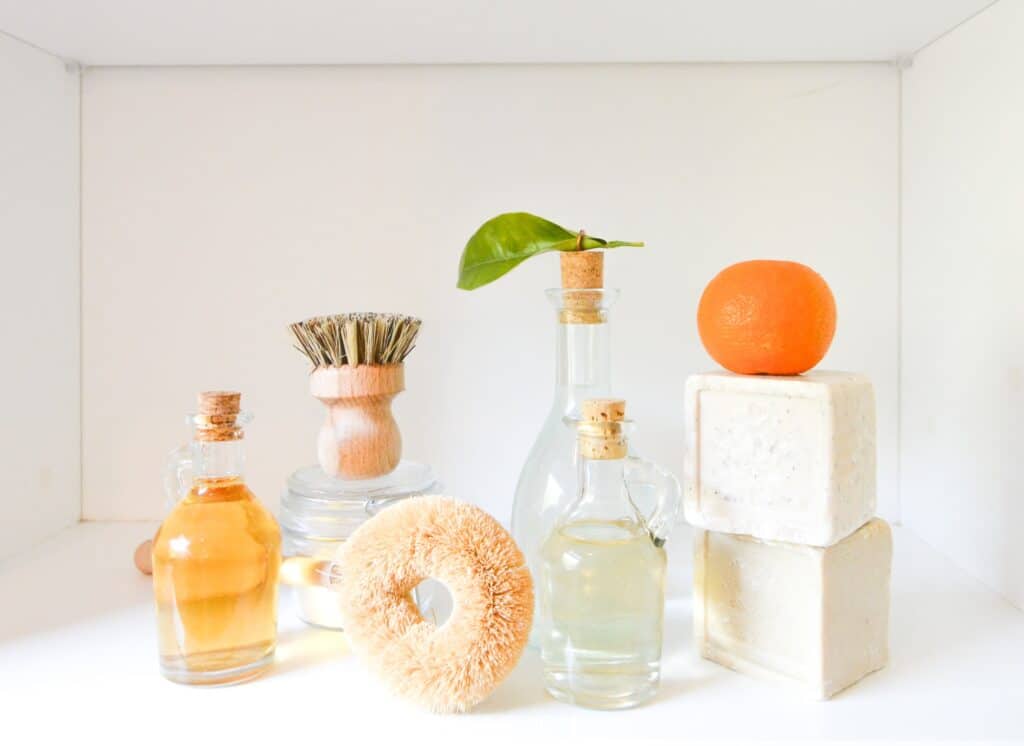Think about standing in the hair care section of your store, faced with a sea of shampoo, conditioner, and other hair products. You’re trying to pick the best ones for your hair type and style, but don’t want it to contain harmful ingredients. It may seem tough, but it doesn’t have to be.
Always check the ingredient list. Avoid toxic ingredients like sodium lauryl sulfate, synthetic fragrance, and formaldehyde that could harm your hair. Instead, opt for a hair product with natural ingredients, like coconut oil or essential oils, for healthier hair.
The fact of the matter is, many everyday personal care products, including hair care, often have harmful chemicals. But don’t worry, you can learn to identify these bad ingredients and choose safer alternatives.
In this guide, we’ll explore the everyday harmful ingredients in hair products. We’ll also share how to avoid these toxic chemicals, and suggest better alternatives.
Your hair health matters, so it’s important to make smart choices.
1. Silicones
What it’s for: Providing smoothness
What it’s used in: Shampoo and conditioner
Risks: Scalp irritation, potential carcinogen, possible hormone disruptor
Silicones are often used in hair conditioners and styling products to give your hair a smooth, shiny appearance. However, these might not be as beneficial as they seem.
Common silicones in hair products include:
- Dimethicone
- Phenyl Trimethicone
- Cyclomethicone
- Cyclopentasiloxane
- Cyclohexasiloxane
Despite the immediate smooth feel, silicones can build up over time, forming a layer that blocks moisture from entering the hair follicle, leading to dryness. They can also weigh your hair down, affecting its natural bounce and curl. So, while they may provide temporary shine, silicones may not be the best for your hair’s long-term health.
2. Parabens
What it’s for: Preservative
What it’s used in Shampoo and conditioner
Risks: Scalp irritation, hormone disruption, possible carcinogen
Parabens are a type of preservative frequently used in a wide range of cosmetic and hygiene products, including hair care products like shampoos, conditioners, and hair styling products. They are used to prevent mold and bacterial growth to ensure that the product is shelf stable for a longer period of time.
Parabens have been in use for several decades due to their effectiveness and low cost. They are typically listed on ingredient labels as methylparaben, propylparaben, butylparaben, or ethylparaben.
Despite their widespread use, there are concerns about the safety of parabens. Studies have suggested that parabens can penetrate the skin and stay in the tissue, leading to an accumulation over time. Parabens are believed to mimic estrogen in the body, a phenomenon known as endocrine disruption. This disruption can potentially lead to hormonal imbalances and has been linked to increased risk of breast cancer and reproductive toxicity.
Furthermore, parabens may cause skin irritation or contact dermatitis in individuals with paraben allergies. While such allergies are relatively rare, they can be severe in some cases.
3. Formaldehyde
What it’s for: Smoothing and straightening
What it’s used in Hair straightening products, shampoo, conditioner
Risks: Scalp irritation, hair loss, respiratory problems, possible carcinogen
Formaldehyde is a versatile chemical found in many products, including hair care. It’s sometimes labeled as Methylene glycol or Formalin. It’s used to provide cleansing or smoothing effects and may be in treatments like keratin masks.
Formaldehyde can irritate sensitive skin and isn’t always listed on the ingredient list. It may still be present even in a hair product labeled “formaldehyde-free”. It’s also found in some hair straighteners, which are linked to health risks. For instance, a 2022 study found that frequent use of chemical straighteners could increase uterine cancer risk. So, remember to make careful choices when it comes to your hair products.

4. Sulfates
What it’s for: Creating lather in shampoo
What it’s used in: Shampoo
Side effects: Scalp irritation, frizzy hair, allergic reaction
Sulfates are used to make shampoos foamy and help clean away dirt and oil. While the bubbly shampoo might feel nice, these chemicals can harm your scalp, change your hair texture, or cause allergies.
Common sulfates include:
- Ammonium Lauryl Sulfate
- Sodium Lauryl Sulfate (SLS)
- Sodium Laureth Sulfate (SLES)
This toxic ingredient not only causes dry skin, but SLES can also contain traces of 1,4-dioxane, a harmful chemical linked to cancer.
5. Phthalates
What it’s for: Acts as a solvent and preservative
What it’s used in: Shampoo, conditioner, styling products
Risks: Potential carcinogens and hormone disruptor
Phthalates, often termed as “everywhere chemicals” due to their widespread use, are a group of chemicals that enhance the properties of hair care products. They’re typically used to dissolve other ingredients, like dyes and fragrances, to make them last longer.
Currently, phthalates are being scrutinized for their potential impact on the human endocrine system. Research suggests that prolonged exposure could interfere with hormone signaling and harm the reproductive system. Studies have also associated phthalates with increased mortality from cardiovascular disease in older adults. Due to these concerns, phthalates have been banned in Canada. However, in the United States, they aren’t required to be listed on ingredient labels.
One way to avoid these chemicals is to opt for “phthalate-free” products.
6. Selenium Sulfide
What it’s for: Fights infections
What it’s used in: Anti-dandruff treatments
Risks: Skin irritation, known to cause cancer
Selenium sulfide is a component in medicated shampoos designed to alleviate dandruff and scalp irritation. However, this compound can be harmful if ingested or if used excessively.
Notably, selenium sulfide can irritate the skin and potentially cause permanent hair loss. While there are safe exposure limits, consider safer alternatives, such as tea tree oil or lemongrass oil, for combating infections.
7. Coal Tar
What it’s for: Adds color to products
What it’s used in: Hair dye and gels
Risks: Potential carcinogen
Coal tar is a byproduct of coal processing, and is used to add color to a number of cosmetics, including hair gels and dyes. However, it’s important to know that it’s a potential carcinogen, meaning it could contribute to cancer development, especially in the digestive tract, lungs, bladder, and kidneys when exposed to high concentrations.
Notably, coal tar could contain other harmful carcinogens. Owing to these health risks, it has been banned in Europe and Canada. Yet, in the United States, it’s still legal to use in certain products.
8. Added Fragrance
What it’s for: Enhances product scent
What it’s used in: Shampoo and conditioner
Risks: Skin irritation
Your shampoo might leave your hair smelling like cherries and vanilla, but it’s not due to actual cherries or vanilla. These fragrances are typically synthetic, added to improve the scent of the products, and often come from potentially harmful petrochemicals.
Most importantly, manufacturers aren’t required to disclose the specific ingredients used to create these fragrances. This means that your scented shampoo could contain a mix of irritants or even harmful chemicals. Opting for fragrance-free or naturally scented options can be a safer bet.

9. Benzene
What it’s for: Used as a solvent in dyes
What it’s used in: Hair dye and dry shampoo
Risks: Weakens the immune system, possible birth defects
Benzene, a solvent derived from petroleum, is commonly used in hair dyes. It’s acknowledged as toxic in large amounts, and may lead to cancer with prolonged exposure.
Benzene may also cause certain birth defects and damage the immune and nervous systems in pregnant women. This ingredient might be listed as toluene, methylbenzene, phenylmethane, or toluol.
A significant number of Procter & Gamble hair care products, mainly aerosols and dry shampoo, were recalled due to the presence of Benzene, a recognized carcinogen.
10. Alcohols
What it’s for: Enhances product absorption and acts as a drying agent
What it’s used in: Shampoo, conditioner, styling products
Risks: Dry hair and scalp irritation
It might be surprising to see alcohol listed on your shampoo or conditioner ingredients, but it’s a very common ingredient in hair care products. It helps your hair and skin absorb the product more effectively. Because alcohol evaporates so quickly, it doesn’t leave behind a residue.
However, this quick-drying quality can also dry out your scalp and hair, leading to irritation and dryness. If the ingredients list includes alcohol near the top of the list, it’s best to look for a substitute that won’t be as damaging in the long run.
11. Mineral Oil
What it’s for: Moisturizing agent
What it’s used in: Curling and smoothing treatments
Risks: Drying out hair, weighing hair down
Mineral oil is a cheap oil used in hair products for conditioning and detangling. While it does provide a protective coating and glossy shine, it’s less effective than other oils.
Unlike natural oil, mineral oil can’t penetrate the hair follicle or add real moisture to your hair. Nor can it repair split ends or hair damage. It’s more of a quick fix that can actually dry out your hair over time. Moreover, it’s heavy and can make your hair feel flat, not soft and bouncy.
12. Para-phenylenediamine (PPD)
What it’s for: Enhances hair dye color
What it’s used in: Hair dyes
Risks: Scalp irritation, increased sensitivity to UV light
Paraphenylenediamine is a chemical used in permanent and semi-permanent hair dye. This potent ingredient can irritate the scalp and increase your skin’s vulnerability to UV rays, increasing the possibility of sunburns and skin cancer.
Research has established a connection between PPD usage and allergic reactions to hair dye. This association is particularly strong for those who fuse hair dye frequently or leave it on for extended periods. Instead of using hair dyes containing PPD, consider switching to less damaging options made of natural dyes.
Ongoing lawsuits against the hair dye brand “Just for Men” allege that their products that contain PPD led to allergic reactions and other skin problems. These reactions have reportedly caused scarring, discoloration, and even some hospitalizations.
13. Resorcinol
What it’s for: Used for bleaching
What it’s used in: Hair dyes and anti-dandruff treatments
Risks: Skin irritation, potential hormone disruption
Resorcinol, an organic compound, is commonly used in hair dyes as a bleaching agent, and as a treatment for conditions like dandruff and psoriasis.
However, at high levels, resorcinol can cause serious eye damage, impact the nervous system, and lead to breathing issues. Additionally, it may interfere with hormone production and disrupt the endocrine system.

14. Triclosan
What it’s for:Acts as an antibacterial agent
What it’s used in: Shampoo
Risks: Disrupts hormone function
Triclosan is a chemical included in shampoos for its antibacterial properties. It used to be common in soaps, but was banned by the FDA in 2016.
Triclosan is known as a hormone disruptor. High levels of exposure can lead to reduced thyroid hormone levels. Some researchers also suggest that triclosan could contribute to antibiotic resistance in certain bacterial strains, posing a threat to our health.
15. Chemical Dyes
What it’s for: Adds color to products
What it’s used in: Styling products
Risks: Skin irritation
The vibrant, synthetic colors of gels and serums in your hair care products may be pleasing to the eye, but they might not be safe for your hair or skin.
These colors often come from dyes derived from petrochemicals. While some of these chemicals have been deemed safe by the U.S. Food and Drug Administration, others are still being studied for their potential long-term effects. So, while they might make the product look attractive, they may not be the best for your hair and scalp health.
16. Polyethylene Glycols (PEG)
What it’s for: Adds thickness to products
What it’s used in: Conditioner and hair cream
Risks: Skin irritation
Polyethylene glycol is a byproduct of petroleum used to thicken hair care products. While current research hasn’t definitively established the toxicity of PEG, it is under scrutiny for potential connections to severe scalp irritation and skin damage.
It’s important to note that not all PEGs are the same. Certain types are considered safe for cosmetic use, while others are still under investigation for their safety. Always check the labels of your hair care products and exercise caution where necessary.
17. Retinyl Palmitate
What it’s for: Enhances collagen production
What it’s used in: Conditioner
Risks: Skin irritation, potential carcinogen
Retinyl palmitate, a blend of retinol and palmitic acid, is known for its anti-aging benefits, which promote skin cell renewal. This can lead to improved scalp health. However, it’s not without risks.
Use of retinyl palmitate can cause severe skin redness and irritation. Similar to retinol, it can make your skin more sensitive to UV rays, increasing the risk of sunburns and potentially, skin cancer.
How to Find Hair Care Products with Ingredients
Picking safe hair care products can seem daunting due to the plethora of potentially harmful ingredients. Fortunately, we have a few tips that can help you identify safe and beneficial ingredients.
Look out for these ingredients as substitutes for harmful ones:
- Sulfate-free mild surfactants help enhance curls without causing product build-up or stripping your hair of its natural oils.
- Humectants, like aloe vera or coconut oil, are great for attracting and sealing in moisture. They also help repair hair damage.
- Seed oils, such as avocado oil and jojoba oil, can keep your hair soft, shiny, and well-protected.
- Butters, like shea or tamanu, can moisturize your hair without clogging pores or weighing down your hair.
If you’re unsure about a product, spend some time researching its ingredients on the manufacturer’s website. This will help you identify any potential irritants or toxic chemicals, as well as non-toxic ingredients that might cause allergies that are specific to you.
Hair Care is an Important Part of Your Health
Navigating the hair care aisle can be a daunting task, given the myriad of products filled with a wide array of ingredients, some of which can potentially harm your hair and health. This article has examined the harmful ingredients commonly found in hair care products, ranging from silicones, parabens, and formaldehyde, to alcohols, resorcinol, and chemical dyes. These substances have been linked to numerous side effects, including scalp irritation, hair loss, hormone disruption, and potential carcinogenicity.
The key takeaway is to always scrutinize the ingredient list of each personal care product you buy. Avoid products with harmful chemicals, and instead, opt for ones that contain natural ingredients like coconut oil and essential oils. By doing so, you are making a choice for healthier hair and a healthier you.
References
- https://fragrancematerialsafetyresource.elsevier.com/sites/default/files/AB-2-Bickers-Safety.pdf
- https://medlineplus.gov/druginfo/meds/a682258.html
- https://ntp.niehs.nih.gov/ntp/htdocs/lt_rpts/tr568_508.pdf
- https://pubchem.ncbi.nlm.nih.gov/compound/Resorcinol
- https://pubmed.ncbi.nlm.nih.gov/14745841/
- https://pubmed.ncbi.nlm.nih.gov/36245087/
- https://www.fda.gov/cosmetics/potential-contaminants-cosmetics/14-dioxane-cosmetics-manufacturing-byproduct
- https://www.fda.gov/news-events/press-announcements/fda-issues-final-rule-safety-and-effectiveness-antibacterial-soaps
- https://www.ncbi.nlm.nih.gov/pmc/articles/PMC4505343/
- https://www.ncbi.nlm.nih.gov/pmc/articles/PMC5929949/
- https://www.ncbi.nlm.nih.gov/pmc/articles/PMC8157593/
- https://www.ncbi.nlm.nih.gov/pmc/articles/PMC8834979/
